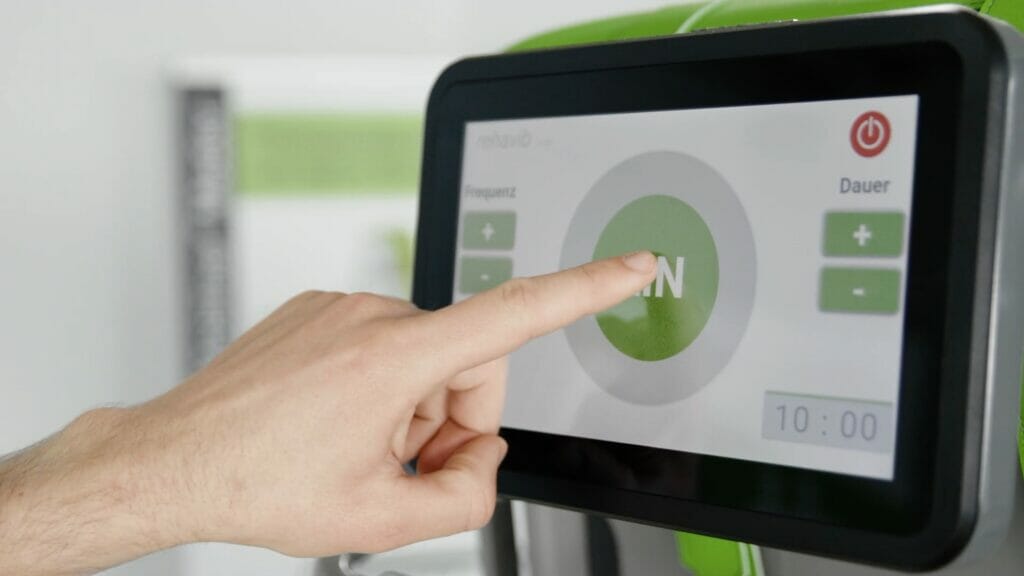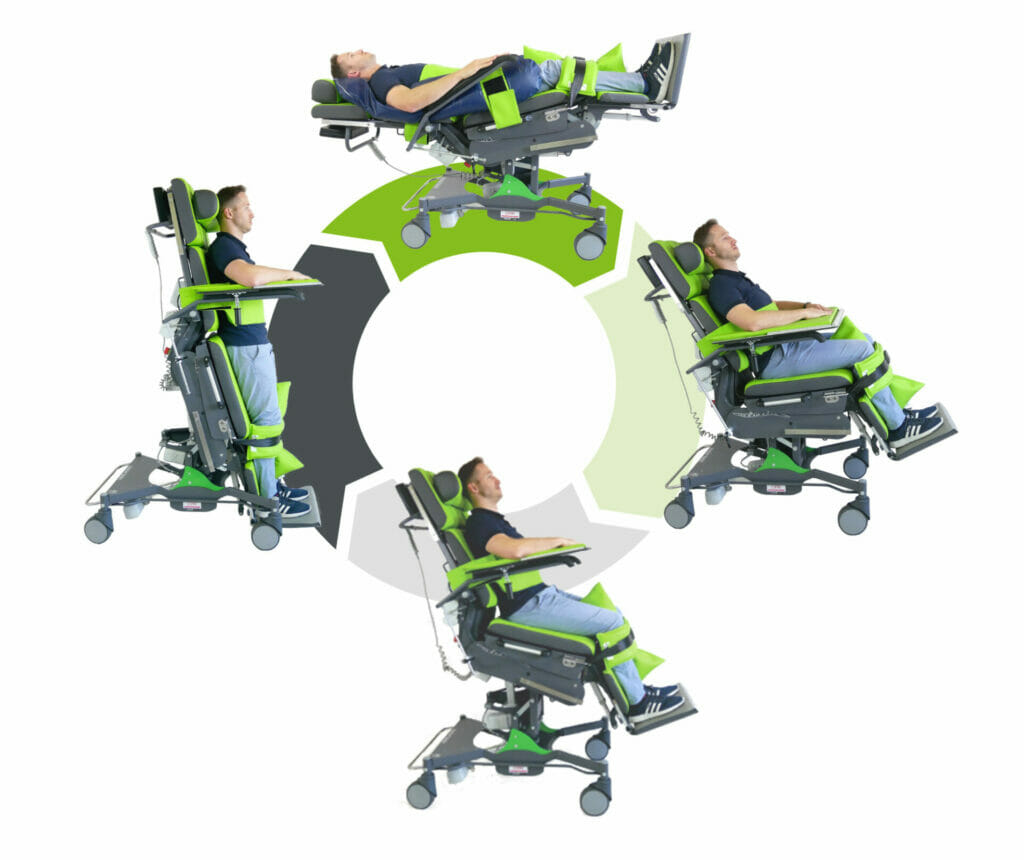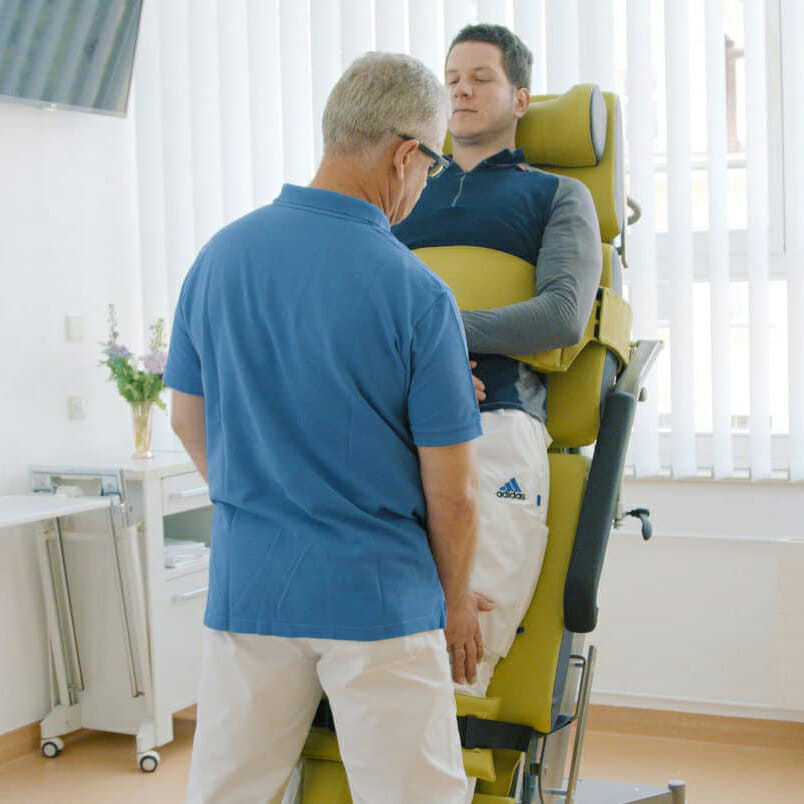Mobilizer® Medior
THE VIBRATION MODULE
The vibration module supports you in mobilising your patients and has a positive effect on the course of therapy.
Mechanical vibration or sound waves are generated in the housing of the vibration module. These can be controlled between 10 Hz and 55 Hz.
With the vibration unit in the footrest, the movement takes place horizontally. This means that the upper side of the footrest always moves sideways back and forth in the micrometre range. In the process, the upper and lower sides of the footstep are kept separate from each other by buffers.
The vibration frequency is regulated by the speed of the motor, which causes the upper side of the footrest to vibrate by creating an imbalance.
CONTROL MODE STOCHASTIC LINEAR & RANDOMISED
The vibration frequency can now be generated in two different control modes, namely either stochastic linear or stochastic randomised (at random).
Control mode stochastic linear
The horizontal movements of the standing surface are stochastically linear. The basic frequency is set by the therapist and can be changed or stopped during the treatment via a touch screen. The treatment time can also be defined by the therapist.
Stochastic means that at the same time the basic frequency is subject to additional influences (noise) and is thus influenced or superimposed.
This “noise” is caused by a special bearing of the buffers.
Control mode stochastically randomised
In stochastic randomised mode, the therapist sets an upper limit (e.g. 35Hz). At the start, the “random generator” (randomisation) starts to change the vibration frequency several times between a lower limit of 10Hz and, in this example, 35Hz in a time window of one minute. The therapist sets the treatment time, but as in the stochastic linear mode, can stop, shorten or lengthen the time at any time.
Stochastic also means here that at the same time the basic frequency is subject to additional influences (noise) and is thus influenced or superimposed.

Whole-body vibration has been shown to have a positive effect on coma and coma patients in particular. Early mobilisation through vibration opens up opportunities to promote vigilance, strengthen muscles and prevent pneumonia and thrombosis.
THE APPLICATION OF THE VIBRATION MODULE IS SUPPORTED:
- Vigilance promotion
- positive delirium management
- Pneumonia, osteoporosis and contracture prophylaxis
- Promotion of neuroplasticity
- stimulation to prevent polyneuro- and myopathies
- Voice – tone regulation and perceptual enhancement
- Swallowing – activation of the musculature
- Speech – improved control of the musculature
- Myofunctional therapy – activation of hypotonic musculature
Spasticity – Improved motor function, e.g. grasping function.
Neglect – Improved exploration to the affected side
Pain Increased
– Increased ability to move due to pain reduction
– Increased self-motivation through pain reduction
- Sensorimotor functions – improved trunk control and body awareness
- Spasticity – improved movement patterns of the extremities
- Pain
– Increased mobility through pain reduction
– Increased self-motivation through pain reduction - Contractures – loosened tissue adhesions and contracture reduction
Vibrational stimulation improves vigilance
CASE REPORT: Whole-body vibration improves cognitive functions of an adult with ADHD
- Anselm B. M. Fuermaier
- Lara Tucha
- Janneke Koerts
- Meinris van den Bos
- G. Ruben H. Regterschot
- Edzard B. Zeinstra
- Marieke J. G. van Heuvelen
- Eddy A. van der Zee
- Klaus W. Lange
- Oliver Tucha
Received: 20 October 2013 / Accepted: 7 July 2014 ©Springer-Verlag Wien 20
Vibration therapy and upright standing COPD patients
Vibration therapy and upright standing improves functional performance in patients with chronic obstructive pulmonary disease (COPD).
Furness, T.
Joseph, C.
Welsh, L.
Naughton, G.
Lorenzen
C. Whole-body vibration as a means of preventing dyspnoea during physical activity: a community-based proof-of-concept trial. BMC Res. Notes 2013, 6, 452.
Vibration therapy is safe
Vibration therapy is safe. Vibration therapy in the standing position does not lead to dyspnoea despite the involuntary muscle contractions.
29 Gloeckl, R.
Richter, P.
Winterkamp, S.
Pfeifer, M.
Nell, C.
Christle, J.W.
Kenn, K.
Cardiopulmonary response during whole-body vibration training in patients with severe copd. ERJ Open Res. 2017, 3

Vibration therapy reduces pain induced by immobility
Vibration therapy activates the muscles, relaxes and helps to reduce pain.
Vibration therapy is about movement
It is about small power impulses that activate muscles, circulation and bones.
Further link to OSD Osteoporosis Selbsthilfegruppen Dachverband e.V.
Vibration therapy reduces the risk of osteoporosis
The risk of osteoporosis is greatly increased in patients who are permanently immobile.
Vibration therapy (Low Intensity Vibration LIV) and loading of the skeleton through straightening – The special mode of action of the Mobilizer® vibration module through exclusively horizontal movement and the possibility to control the frequency between 10Hz-15Hz (LIV) makes this possible.
PROCEDURE
The patient is verticalised (straightened up). It is recommended to put the patient in a position where the seat inclination is at least 10° forward. A complete standing position is desirable but not a prerequisite for successful stimulation. The sensory system can also be stimulated while lying or sitting. Studies show that local increased blood flow (primarily in the sole of the foot and lower leg) is initiated via the deep tissue stimulation. This leads to a stimulation of the musculature and bone metabolism. Vibration or sound waves hit muscles, tendons and nerves and trigger a tonic vibration reflex (TVR).
BY STIMULATING MUSCLE SPINDLES AND THE PROPRIOCEPTIVE SYSTEM, MUSCLE FUNCTION IS IMPROVED AND
- muscle function is improved and muscle tone is normalised.
- Loss of bone density is counteracted. OSD-EV.org
- Counteracts loss of strength due to muscle atrophy.
- Supports orthostatic blood pressure regulation
- Spasticity is reduced
- improves motor control
- Postural control is improved
- Vigilance and consciousness are challenged

The method of vibration training in intensive care medicine is based on the results of the Russian sports scientist and biomechanist Prof. Dr. Nazarov. Under the term Biomechanical (Muscle) Stimulation (BMS) or Rhythmic Neuromuscular Stimulation (RNS), Nazarov tried to reduce the muscle atrophy in cosmonauts caused by their stay in weightlessness by applying mechanical vibrations at the end of the 1970s, which he also succeeded in doing.
Prof. Gerstenbrand 2012:
“In Moscow, a so-called “pressure shoe” is already being produced for stimulating the sole of the foot, and we are also developing a stimulation shoe. Our research group has found a new system for measuring foot sole stimulation. A foot sole vibration immediately causes increased blood flow in the associated sensorimotor areas. Not only on the opposite side, but also on the same side for stimulation. The thalamus, the control centre of the brain, is also activated, as well as the frontal brain and the temporal lobe. The method used for the study was functional MRI, applicable also in Parkinson’s disease and apallic syndrome, and also for prognosis.”
Activation of the thalamus
The activation of the thalamus, the frontal lobe and the temporal lobe by local vibration has been demonstrated in numerous studies.
The thalamus controls our motor functions
the orbitofrontal cortex (frontal lobe) is responsible for, among other things, drive, attention and concentration → vigilance
the temporal lobes are responsible for our hearing, the speech centre and the sensory cells (smell, taste).
THE VIBRATION THERAPY
Vibration therapy is used to treat spasticity (tone control), hemineglect and sensorimotor disorders. Another effect of vibration therapy is that the transmission of pain signals to the brain is interrupted (gate-control theory).
GATE-CONTROL THEORY
The gate-control theory or control barrier theory states that the spinal cord has a neurological gate that stops pain signals or allows them to pass through to the brain. This gate is opened by the activity of pain signals rising up the fine nerve fibres and closed by activity in thicker fibres or by signals coming from the brain. Neurologically, according to the Gate Control Theory, external and internal pain stimuli are received by pain receptors (nociceptors) in the skin, muscles, joints and internal organs and are connected in the posterior horn of the spinal cord (Rexed zones I, II and V) to the second neuron of the pain pathway. Since many neurons from the periphery converge on a single neuron, this is called a wide dynamic range neuron (WDR neuron). This wiring is subject to very strong modulation by other neurons (Stangl, 2019).
Literature used:
Stangl, W. (2019). Keyword: ‘gate control theory’. Online encyclopaedia of psychology and education.
Source: https://lexikon.stangl.eu/3532/gate-control-theorie/ (2019-09-23)
